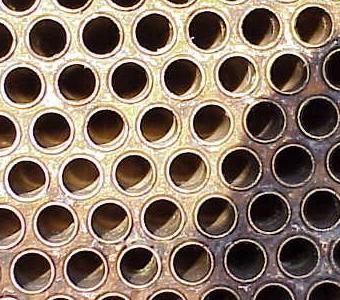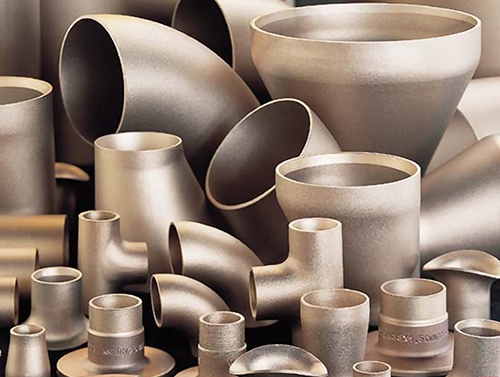Contents
- Condenser and Heat Exchanger Tubes
- Tubesheets
- Piping
- Fittings
- Pumps
- Valves
- Water Boxes
- Useful References/Links
Condenser and Heat Exchanger Tubes
Applications
| Industry | Application |
|---|---|
| Power Station | Condenser, feed water heater, air ejector, water cooler, oil cooler, hydrogen cooler |
| Nuclear Power Station | As above plus mist separator |
| Shipping | Main condenser, auxiliary condenser, drain cooler, feed air heater, air cooler, steam generator, refrigeration, air conditioning, tank heating coils, hydraulic system |
| Petrochemical | Process heat exchanger, cooler and condenser, process reboiler, boiler feed heater, oil cooler, generator turbine condenser, air compressor inter and after cooler |
| Chemical Industry | As above |
| Desalination | Heat exchangers for heat recovery, heat rejection and brine heater sections |
| Refrigeration, ventilation and Air conditioning | Condenser, brine evaporator, heater etc |
The upper working temperature for 90-10 and 70-30 Cu-Ni is normally about 250°C.
 Copper-nickel tubesheet.
Copper-nickel tubesheet. Copper-nickel fittings, reducers and elbows.
Copper-nickel fittings, reducers and elbows.Photo courtesy of KME
Useful References/Links: 7, 9, 14, 15, 16, 17
Velocity
Heat exchangers are designed for flow rates more than 1m/s. The higher the velocity the greater the heat transfer efficiency but velocity is limited by pumping cost, pressure drop across passes, tolerance limits of materials. Normally design velocity for Cu-Ni is 1.8-2.5m/s based on uniform non-turbulent flow through the system.
| Typical maximum velocities for diameters less than 25mm. | |
|---|---|
| 90-10 | Unpolluted sea water about 2.5m/s. With entrained sand, 2.0m/s Fresh water: about 4m/s |
| 70-30 | Unpolluted sea water about 3.0m/s. With entrained sand 2.4m/s |
| 66-30-2-2 | Unpolluted sea water 4.5m/s. With entrained sand 3m/s |
Commissioning, Operation and Shutdown
Useful References/Links: 1, 3, 7, 13
Back to TopTubesheets
 Copper-nickel tubesheet.
Copper-nickel tubesheet.Tubesheets should not be more noble than the tubes as this can cause a galvanic influence on the corrosion rate of the tube ends. Therefore 90-10 Cu-Ni tubesheet can be used with 90-10 Cu-Ni tubes. Also, Naval brass, Muntz metal and aluminium bronzes are slightly anodic to 90-10 Cu-Ni tubes and are therefore compatable.70-30 tubes should have 90-10 or 70-30 tubesheets. For clad tube sheets, welded tube to tube sheet joints are preferred.
There are many different tube/tube sheet (T/TS) weld joint designs used in industry and each has their particular advantages and disadvantages. The more common joints are the flush tube, recessed tube, trepanned tube sheet, added-ring and face side fillet weld when the weld is made on the tubesheet face.
Useful References/Links: 12
Joining Tubes-to-Tubesheet
In heat exchangers and condensers, tubes are joined to tubesheets to prevent leakage between the tube side and shell side. Often the easiest and least expensive method is to mechanically expand the tube into the drilled hole in the tubesheet usually by roller expansion. Ideally the tubesheet should be harder than the tubes. A mechanically expanded joint may be acceptable when :
- Service temperatures are low e.g. under about 200°C
- Tube sheets are sufficiently thick to allow rolling-in a suitable length of tube
- Design pressures are relatively low
- A weld joint is not needed to support the tube bundle
A mechanical joint is not used for severe services where a leak could present a catastrophic safety hazard.
When a tube-to-tubesheet weld is made in a Cu-Ni construction, it is most often an automatic gas-shielding tungsten arc (TIG) weld made either with or without filter metal. Manual welding might be used on special designs and is often the standard method for weld repairing. With manual welding filler metal addition is recommended, particularly to avoid porosity from lack of complete gas shielding over the molten weld metal. While the TIG process is well adapted to make T/TS welds with thin wall tubes, other welding processes may be better suited for large diameter and thinner wall tubes. Alternate welding processes include manual metal arc (MMA), metal inert gas (MIG) or plasma arc. Explosion welding is another joining option although it is seldom used in Cu-Ni construction.
There are many different T/TS weld joint designs used in industry and each has their particular advantages and disadvantages. The more common joints are the flush tube, recessed tube, trepanned tube sheet, added-ring and face side fillet weld when the weld is made on the tubesheet face.
Selection of a particular automatic TIG weld joint configuration involves considerations such as the following:
- joint crevice leak path size requirement
- filler metal requirements
- tubesheet heat sink
- structural flexibility
- available equipment
- tube dimensions and ligament size
Successful T/TS welding depends to a very high degree on the accurate machining of holes, joint preparation on the tubesheet and cleaning all surfaces prior to welding. Accurately machined holes are particularly essential for automatic welding to assure the tungsten electrode is always positioned correctly in the weld joint. Cleaning problems start with the contamination of the tubesheet by the hole drilling lubricants. The tubesheet should be cleaned immediately after drilling and positioned so that during cleaning the contaminants drain from the tubesheet and do not accumulate on one surface. Compressed air should not be used to 'blow off' the cleaning solution unless equipment is installed to remove the normal moisture and oil contamination. Dry nitrogen is often a good alternative to compressed air.
Prior to T/TS welding, it is often desirable to expand the tube into the tubesheet, for example by a 'light roll' to assure the tube is centred in the hole for good tracking in automatic welding. A 'hard roll' prior to welding increases the chance of producing a weld defect from escaping gas as the weld is being made. After the T/TS weld is made on thicker tubesheets, the tube is often given a 'hard roll' stopping about 25 mm short of the back side.
A visual inspection should be made for weld defects in the completed T/TS weld. A liquid penetrant inspection of the welds is also quite standard. Other inspections that might be imposed are a leak test and in some T/TS designs a radiographic inspection can be made of selected areas. Defects such as cracks or porosity should be ground out and a manual TIG repair with filler metal made.
Useful References/Links: 3, 9, 10, 11
Back to TopPiping
Cu-Ni is used for piping systems in a wide range of sizes. Attention to velocity limits and good commissioning practices are the main requirements to achieve excellent service.
Useful References/Links: 1, 2, 3, 4, 5, 6, 7, 8
Fittings
For a description of fittings and their properties, see System Design section.
Pumps
Centrifugal pumps are often used in seawater systems; the main components being the casing and the impeller. Cast alloys such as gun metal, nickel aluminium bronze and cast copper nickel can be suitable for the casing in copper based piping systems with alloys of resistance to higher water velocities for the impeller such as alloy 400 or nickel aluminium bronze. Appropriate attention has to be given to galvanic considerations when selecting materials.
Useful References/Links: 2
Valves
The three main components of a valve are the body, seats and shafts or stems. Copper based alloys such as nickel aluminium bronze, gun metals and cast copper nickels are often used for valve bodies with alloys which are more noble and have resistance to fast flowing sea water for the seat or stem.
Useful References/Links: 2
Water Boxes
90-10 and 70-30 Cu-Ni alloys are widely used for water boxes in ships and desalination service.
Back to TopReferences
- Application of Copper Nickel UNS C70600 for Seawater Service, Wilhelm Schleich, Paper No 5222, , CORROSION/2005, Houston, NACE International, .
- Care and Maintenance of Copper Alloy Tubed Condensers - Construction through Early Life, Sartor, W. E., , CDA Heat Exchanger Seminar;, New York City, New York, .
- Copper Alloys in Seawater: Avoidance of Corrosion, Roger Francis, Publication 225, pp 20, , CDA UK, .
- Copper-nickel Welding and Fabrication, Published by CDA Inc as A7020-99/13, Nickel Institute as 12014 Second Edition and CDA UK as Publication 139 Second Edition .
- Cu-Ni Seawater Piping Systems, Wildsmith, G., pp 65-71, , Institute of Metals Conference, London, .
- Fine Wall (22BWG) 90-10 and 70-30 Cu-Ni Condenser Tube Use at the Hennepin Energy Resource Company Power Plant, Helliwell, W.E. and Anderson, G.A., , PWR-Vol 30 Joint Power Generation Conference Vol. 2, ASME, .
- Heat Exchangers and Piping Systems from Copper Alloys - Commissioning, Operating and Shutdown, M. Jasner, M. Hecht and W. Beckman, , KME, .
- Heat Exchangers and Piping Systems from Copper Alloys - Commissioning, Operating and Shutdown, M. Jasner, M. Hecht and W. Beckman, , KME, .
- Protection of Seawater System Pipework and Heat Exchanger Tubes in HM Surface Ships and Submarines in Sea Water Systems, Standard 02-781 Issue 2, , UK Ministry of Defence, Not available online but inquiries can be sent to the DStan Helpdesk at [email protected] .
- Seawater System Design, CDA, .
- Copper Nickel Condenser and Heat Exchanger Systems, Kirk, W. and Tuthill, A, Technical Report 7044-1919, , CDA Inc Seminar The Application of Copper-Nickel Alloys in Marine Systems, .
- The Application of Copper Nickel Alloys in Marine Systems. Material Selection for High Reliability Sea Water Systems, B. Todd, Seminar Technical Report 7044-1919, CDA Inc, The Application of Copper Nickel Alloys in Marine Systems. .
- The Design and Installation of 90-10 Copper Nickel Sea Water Piping Systems, Publication 1107, Nickel Development Institute, .
- The Use of Cathodic Portection for Copper Alloys in Seawater Cooling Systems, Berthagen, Leif, Eurocorr 2001, EFC Working Party meeting. Marine Corrosion, .
- Tube/Tubesheet Joining, Gaffoglio, C. J., , CDA Heat Exchanger Seminar, New York City, New York, .
- Typical Failures of 90/10 CuNi Sea water Tubing Systems and How to Avoid Them, Schleich, Wilhelm, , Eurocorr 2004, NACE, .
- Wolverine Engineering Data Book II, Dr. K. J. Bell and Dr. A. C. Mueller, Germany, Wieland-Werke AG, .
- Wolverine Engineering Data Book III, Professor John R. Thome, Germany, Wieland-Werke AG, .
